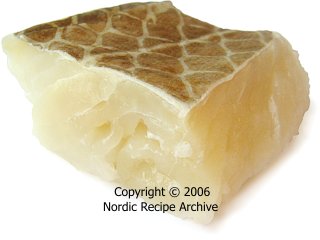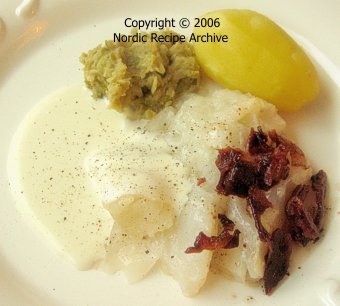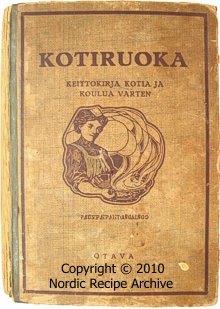
|
|
| MAIN RECIPE PAGE |
|
|
LUTEFISK
Literally translated as "lyefish", lutefisk or lutefish — from the Norwegian lutefisk and the Swedish lutfisk — is an old traditional fish preparation and dish consumed in the Nordic countries of Norway, Sweden and Finland (excluding Denmark and Iceland). In Finland lutefisk is called lipeäkala (= "lyefish"), and is also known by many dialectal names like livekala and likokala, among others. Lutefisk may also be found eaten in some parts of the United States, among the Scandinavian descendants. Lutefisk is made of stockfish — formerly dried cod, nowadays mostly dried ling and saithe — by slowly rehydrating it first in cold water, then in a strong alkaline solution, which gives the fish a soft, almost jelly-like consistency. Finally, the fish is rinsed and soaked in water to remove the excess alkaline substance and baked, poached or steamed until white and flaky. Cooked lutefisk has a very mild flavour and although it has a characteristic, somewhat pronounced odour, it does not much differ from the strong odour of regular fresh cod. In spite of this, people have divided opinions on the deliciousness of the dish, some loving it ardently, others feeling sick just from the smell of it. Lutefisk tradition Because stockfish kept well and was high in protein, dishes prepared from it, like lutefisk, were perfect food to be eaten in Roman Catholic countries on fast days, when eating meat was prohibited. Although the exact origin of lutefisk is unknown, lye-soaked fish is known to have been prepared in Europe already in the 15th century. Lutefisk was a festive dish in the 16th century catholic Sweden, and has remained so even after the Protestant Reformation. Although fasting is no longer practiced in the protestant Nordic countries, lutefisk is still enjoyed here especially in Christmas time. In Finland, lutefisk may nowadays be eaten especially on Christmas Day as a light, alkaline dish to counterbalance the heavy, fatty and acidic food served at the main Christmas dinner, eaten on Christmas Eve. Besides being served on its own, lutefisk is also used as an ingredient in other dishes, from soups, omelettes and forcemeats to soufflés and puddings. Being a light, easily digestible dish high in protein and low in fat, lutefisk is perfect food to be included in today's health-conscious diet — at least by those who can abide its peculiar smell and taste :-) See a traditional recipe for cooking and serving lutefisk here. MAKING OF LUTEFISK See two "vintage recipes" for making lutefisk from scratch at the bottom of this page. Even today, preparing lutefisk is a time consuming process. It takes about three to four weeks to convert stockfish into lutefisk. Starting with stockfish In the Nordic countries, lutefisk was traditionally prepared from stockfish made of Lofoten Islands cod (Gadus morhua), caught off the coast of northern Norway. Because of the decline of cod stock, most lutefisk sold today in Sweden and Finland is prepared from dried ling (Molva molva) and saithe/coalfish (Pollachius virens), but also cusk/tusk (Brosme brosme), whiting (Merlangius merlangus) and hake (Merluccius merluccius) are sometimes used. Previously also other white fish were used to make lutefisk, like pike, pike-perch, burbot, powan and bream. Most Norwegian lutefisk is, however, still made with cod, with the Lofoten cod, skrei in Norwegian, being the most preferred type of codfish used. Lutefisk made with ling has a white, fine texture and a mild flavour, whereas lutefisk made with saithe has a coarser texture and a more pronounced flavour. Stockfish is prepared traditionally by hanging fish fillets out to dry in the open air in cool wind, at a temperature just above the freezing point, the climate of North Norwegian and Swedish coasts being just ideal for this. Nowadays the air-drying is also done mechanically in a controlled atmosphere, producing stockfish of a more uniform quality, but lacking the fully developed flavour of naturally dried fish. After several weeks, the fish has dried into a hard slab that will keep for years if stored in a dry and cool place. Reconstituting stockfish Stockfish is first partially rehydrated by submerging it in cold water or keeping it under cold, dripping water for several days — usually about three to five days. In some recipes the fish is also hammered with a wooden mallet to soften it before soaking. The soaking time varies according to the size and dryness of the fish and whether it has its skin attached, taking anywhere from about three days to several weeks. During the entire process, it is important to keep the fish cold by using ice and cold water, changed at least twice a day to prevent bacterial growth. The water temperature should not exceed +10 °C. Treatment with lye — "luting" Instead of soaking stockfish in water only, adding an alkaline substance will cause the dried fish to swell into an even bigger size than what it was when fresh. The high alkalinity charges the muscle fibre proteins with positive electricity, making them repel each other and weaken their bond, resulting in a flesh with jelly-like consistency. Because of their strong causticity, great care should be taken when preparing and handling the following products and solutions made with them to avoid chemical burns and eye injuries. Carefully study the labels of each product package and follow the given instructions. Use dense protective gloves and do not use dishes or utensils made of aluminium or zinc because lye will corrode them. It is advisable to ensure proper ventilation too, since the preparations will emit a somewhat strong odour. The alkalinity can be created using various substances:
A weight is placed on the fish and it is left to soak for from three days to one week, or until sufficiently swelled and softened. It is important not to let the fish soak for too long, or its fat will start to saponify, ie convert to soap. Soaking for too long will also cause the proteins in the fish to "melt" when it is cooked, reducing the flesh almost to nothing. The amount and proportions of the luting ingredients used as well as luting time vary greatly according to the quality, texture and the fat content of the stockfish. This is why even the commercially produced lutefisk must be handmade, each batch being controlled by a trained professional with a long experience in the process. Final soaking in water In order to become edible, lutefisk must yet be soaked in plenty of cold water to remove the excess lye. Again, the soaking time depends on the quality of the fish and the type of lye used — if the soaking time is too short, the fish will turn into jelly and disintegrate when cooked, if too long, it will become too hard and firm. Especially during the first days, the soaking water is changed daily. The basicity of the final product has a pH of around 10,5 to 11. SERVING OF LUTEFISK Storing lutefisk Fresh lutefisk will keep for up to one week refrigerated. It may also be frozen. Before the time of refrigerators, lutefisk was stored in snow in wintertime. Lutefisk is nowadays available sold fresh, vacuum-packed and frozen. Frozen lutefisk is thawed before cooking. Cooking lutefisk Recipes for cooking lutefisk vary greatly. Some state that the fish should always be soaked in cold water for from a couple of hours to overnight before cooking, while others advice against even just rinsing the fish with water. In some recipes the fish is salted and left to stand for a couple of hours. Salting or soaking will result in a firmer flesh, although some people like their fish to be more jelly-like. Glass, enamel, stainless steel or glazed ceramic dishes should preferably be used for cooking lutefisk. Aluminium dishes or utensils must not be used, because in course of time the lye in the fish will corrode them. Lutefisk has a very fragile texture and it breaks to pieces easily if not cooked gently. The fish will maintain its shape best if baked in oven/microwave oven. If poached in liquid, the fish should be wrapped in cheesecloth. Regardless of the cooking method used, the fish is first sprinkled or rubbed with salt. If it has its skin attached, it may be removed before cooking. Otherwise, the fish is cooked skin-side down. The fish is done when the flesh is starting to turn white, firm and flaky. There are several methods to cook lutefisk:
In addition, many people like to cook lutefisk in a microwave oven. Serving lutefisk
In Norway, the most common traditional accompaniments for lutefisk are boiled almond potatoes, dried green peas soaked, cooked and pureed, cooked crisp bacon and drippings together with béchamel sauce seasoned with mustard. The Swedes also include pureed green peas with the fish, along with Skåne mustard, made by pounding black mustard seeds into a coarse-textured paste with a dash of water. The Finns traditionally serve béchamel sauce, boiled potatoes, boiled green peas, melted butter and coarsely ground allspice. Although there is a multitude of trimmings to choose from, with new ones introduced yearly, it should be noted that lutefisk is basically a simple dish with a delicate taste, not to be masked with too many additional ingredients. See a recipe for cooking and serving lutefisk and its trimmings here. TRADITIONAL FINNISH LUTEFISK RECIPES
Important note: the recipes below are included for interest only. If you plan to follow them, do it at your own risk, noting that the following chemicals and solutions made with them are corrosive and may cause chemical burns and eye injuries if not handled strictly according to their safety instructions. Preparing lutefisk with wood ash lye 2500 g stockfish Pound the fish (remove the skin with a pair of pincers) and soak in fresh, cold water for six to seven days, changing the water every day. Layer the fish skin-side up with a bit of slaked lime and pour a generous amount of lye water over. Prepare the lye water in the following manner: boil the ash, tied in a cloth bag, the slaked lime and water into a strong lye solution and leave to cool. Store the fish under a light weight until sufficiently swollen, for three to five days. Stir the fish often, so that the lye solution will be evenly absorbed in them. As soon as the fish have softened and the flesh looks clear and bright, transfer them to soak in fresh, cold water, changing the water every day. After about a week the fish are ready to be cooked. Lutefisk is stored in snow. The skin removed from the fish is processed into a clarifier for brewed coffee. Preparing lutefisk with caustic soda lye 2500 g stockfish Pound the fish (remove the skin with a pair of pincers) and soak in fresh, cold water for six to seven days, changing the water every day. Dissolve the washing soda and the slaked lime into cold water and pour over the fish to cover them completely. Store the fish under a light weight until sufficiently swollen, for about six days. Stir the fish often, so that the lye solution will be evenly absorbed in them. As soon as the fish have softened and the flesh looks clear and bright, transfer them to soak in fresh, cold water, changing the water every day. After about five days the fish are ready to be cooked. Lutefisk is stored in snow. The skin removed from the fish is processed into a clarifier for brewed coffee. |
|
|

 In Norway, Sweden and Finland, freshly cooked lutefisk is served with various traditional trimmings, differing only slightly in each country.
In Norway, Sweden and Finland, freshly cooked lutefisk is served with various traditional trimmings, differing only slightly in each country.
 The following recipes are translated from an old Finnish cookbook "Kotiruoka — Keittokirja kotia ja koulua varten" (ca 1942 edition, pictured on right), the first edition of which was published in 1908.
The following recipes are translated from an old Finnish cookbook "Kotiruoka — Keittokirja kotia ja koulua varten" (ca 1942 edition, pictured on right), the first edition of which was published in 1908.